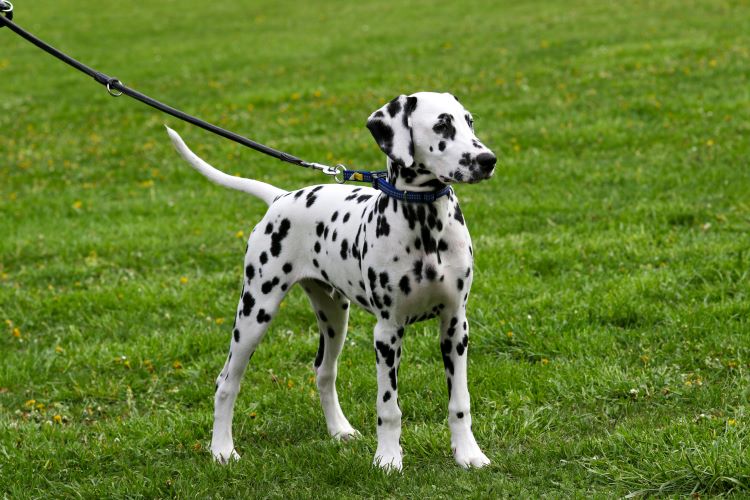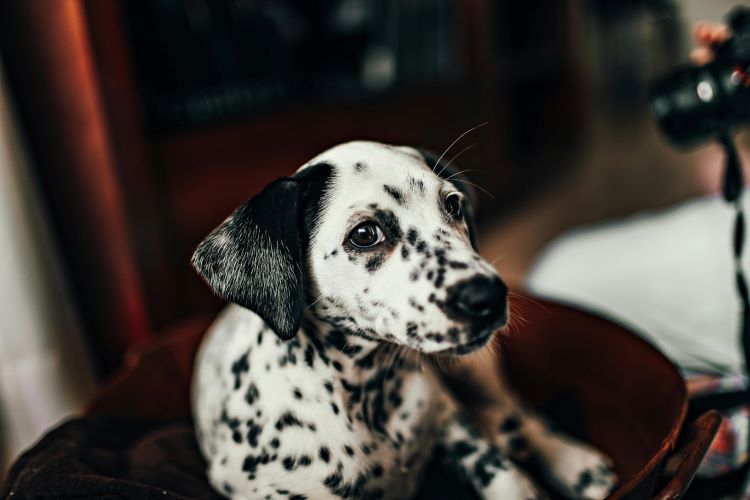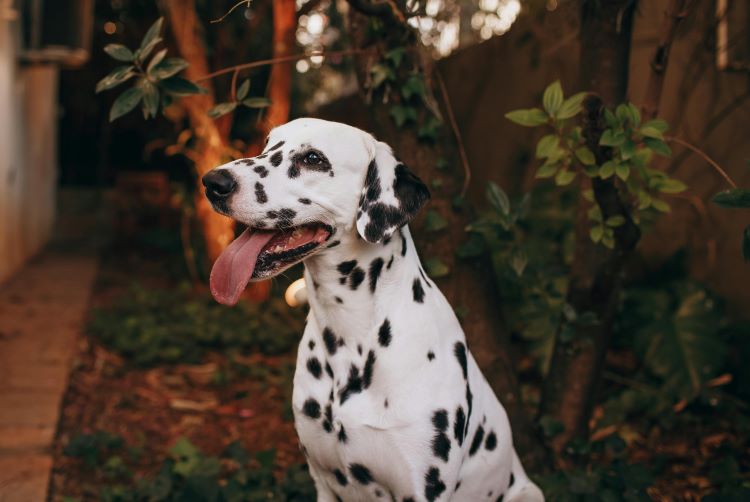Ready to help treat your pet to a healthy life?
Beyond the Spots: A Guide to the Dalmatian Dog Breed
By : Kathleen Crampton & Trupanion Staff | Published Jul 22, 2025

Sporting their distinct spotted coats, Dalmatians are some of the most recognizable dogs on the block. But there’s more to the Dalmatian dog breed than what meets the eye. Underneath their polka-dotted fur, they have nearly boundless energy, loyalty, and physical stamina.
And, as many Dalmatian owners will tell you, they can also make excellent pets. Whether you want to learn more about your own dog, are considering adopting a Dalmatian for the first time, or you’re just curious about canines, we’re going to take an in-depth look at this unique breed. What is a Dalmatian, and why do they have so many spots? What’s their history, temperament, and maintenance needs? Are there certain health concerns potential pet parents need to know about?
This guide answers all of these questions and more, giving you an inside look at the dog that’s not only served as one of the most iconic Disney characters of all time but also brings pet parents joy every day.
5 fun facts about Dalmatians
- Dalmatian puppies are born with plain white coats. Pigmented black or brown spots don’t appear on their fur until Dals are about two weeks old.
- Their exact heritage is largely unknown, but researchers have dated their origins to the 1600s at the latest.
- The breed is extremely energetic and athletic, requiring a lot of daily exercise.
- Though they’re often seen as fire dogs, they were once called “coach dogs” because they would serve as protectors and companions of the horses leading carriages, often running alongside the coach to clear the path.
- One of their biggest claims to fame may be 101 Dalmatians, but this breed made their pop culture debut earlier in 1950 as the Budweiser Clydesdales’ mascot (it’s still the mascot today).
Breed description
Dalmatians, or “Dals,” are one of the most recognizable breeds due to their distinctive coats with large black or brown spots. But why do Dalmatians have spots?
A little known fact about Dalmatians is that they’re actually born without spots! Dalmatian newborns have all-white coats and don’t start showing their famous spots until 10 to14 days after birth. Their skin already has the pigmented spots — it just takes some time for the color to appear on their fur. Spots can continue to appear and grow until Dals are about two years old.
Based on a scientific study from the early 2000s, researchers now believe that pigmented black and brown spots develop because of the interaction of three genes called Piebald, Ticking, and Flecking loci. A more recent study also proposes that the Roan locus contributes to the breed’s distinctive spots. (Dalmatians don’t specifically have roan coats, which appear as mottled or speckled fur, but they do carry a modified version of the gene. Australian Cattle Dogs, for example, have roan coats.)
In addition to their white coats with pigmented spots, Dalmatians also fit the following criteria:
- Height: 19–24 inches (48–61 cm)
- Weight: 45–70 lbs (20–31 kg)
- Build: Sturdy and muscular with strong hindquarters
- Coat: Short, smooth coat
- Life expectancy: 11–13 years

History of the Dalmatian
The history of the Dalmatian isn’t as clear as the spots the breed flaunts. Modern theories seem to pinpoint its origins based on artwork that depicted spotted dogs. And professional canine organizations have different theories.
According to the Federation Cynologique Internationale, the history of Dalmatian may have begun in 16th-century Croatia. The organization places the origins of the breed around this time and location because of a painting in a 1600s-era Croatian church that depicts a dog that looks like a Dalmatian. However, the American Kennel Club proposes that the breed dates back much earlier, potentially to 1700 BC, based on Greek artwork that shows clearly spotted dogs.
Although historians are not sure precisely when the Dalmatian dog breed began, the canine community is clear on one thing: when the Dalmatian started gaining popularity as working dogs throughout Europe. Around the 1700s or 1800s, Dalmatians worked as “coach” dogs for the wealthy, running alongside the horse-drawn coaches and calming and protecting both the horses and passengers.
This job provided a natural segue to becoming “firehouse dogs” in both Europe and North America, as horse-drawn carriages originally carried firefighters and water. (It’s not clear when exactly Dalmatians were brought to North America, but the breed entered the American Kennel Club Stud Book in 1888.) Even when engine-powered fire trucks entered the scene, Dals continued to be kept on at many fire stations. To this day, they are commonly associated with firefighters.
Do Dalmatians make good pets?
Dalmatians can make great pets, just so long as they’re trained from a young age. This breed is known for its protective nature and high amounts of energy; two traits that pet parent hopefuls should be aware of before they bring a Dal home.
Temperament
With their family members, Dalmatians are sweet, snuggly, and affectionate, but they tend to be more shy with strangers. This leads some people to believe that Dals are a standoffish breed, but that’s generally not the case.
Dals are protective of their loved ones, so they might not be as instantly friendly to visitors or passersby on the sidewalk as other breeds, like Golden Retrievers. Dalmatians just might need a little extra time to warm up to strangers and make sure that their family approves. With Dals, loyalty always comes first.
This breed is also quite social and playful, preferring the company of its favorite humans rather than being alone.
Activity levels
Dalmatians are known for being very energetic, hardworking, and athletic, so it makes sense that they were used for various types of jobs throughout their history. But in most modern households, it’s safe to say Dals aren’t doing any dog labor. This makes it crucial that they have ample opportunities to expend their energy, whether through dedicated exercise or a mentally engaging play session.
These polka-dotted dogs will do best with an active family. They tend to be just as happy tagging along on long walks, hikes, or jogs as they will playing an energetic game of fetch at the park. Better yet, pet parents could incorporate both types of activities into their daily routine.
Training needs
Just because they’re loving pets doesn’t mean that Dalmatians are right for every family. Their playful and extremely energetic personalities could be overwhelming to some pet parents, especially those with small children.
But that’s where training comes in. Dals are eager to please, making them very trainable dogs — but they’re also highly intelligent, meaning that they can become stubborn and set in their ways without the right boundaries. Training Dalmatians and socializing them from puppyhood is key to developing good behavior, helping them understand when it’s time to play (and when it’s not), and guiding them in non-aggressive behavior with strangers.

Dalmatian health concerns
There are some common health issues among Dalmatians. While not all Dals will develop these medical conditions, it’s important to be aware of them. Keep in mind that this is not an exhaustive list of health concerns; rather, these are some of the top conditions that have been seen in the Dalmatian dog breed. It’s also no guarantee that your own Dalmatian will get one of these illnesses; it’s just important to be aware of the potential risks and be proactive with your pet’s health.
Staying on top of routine veterinary care and making sure your dog is active and fed a healthy diet are the keys here. With Dalmatians — and any dog breed for that matter — it’s also helpful to have a good dog insurance plan. The right policy will help ensure that your buddy can get the treatment they need for new health surprises as they come up throughout their lifetime.
Deafness
Remember the Piebald gene we discussed earlier? This gene contributes not only to Dalmatians’ spotted coats, but it could also be the culprit for the breed’s predisposition to deafness. Some studies show that approximately 30% of Dalmatians may be born with deafness. While some researchers believe that the extreme presence of the Piebald gene is to blame, others are skeptical of only one gene causing the condition.
Regardless of the genetic explanation, it’s important for breeders and pet parents to look for the signs of deafness in their young pup, like a lack of response to sounds, skittishness with movement, or odd barking sounds. Veterinarians can perform what’s called a BAER (Brainstem Auditory Evoked Response) test to assess your dog’s hearing capabilities.
Urinary stones
Dalmatians are also genetically predisposed to developing urinary stones. Scientists have discovered that a genetic mutation specifically in Dalmatians leads them to develop high levels of uric acid, which can cause urinary stones. This mutation occurs in all Dalmatians, but not all dogs will develop these painful stones. Treatment may involve medicine, diet changes, or surgery.
Copper storage disease
Some dog breeds, including Dalmatians, are predisposed to copper toxicity of the liver, known as copper storage disease. They’re more likely to develop this condition later in life and may display various symptoms, like weight loss, diarrhea, vomiting, and general weakness. If you see these signs, it’s crucial to get your pet to the vet for an assessment and treatment.
Caring for your Dalmatian
Dalmatian grooming and coat maintenance is fairly low-key. While they are known to shed quite a bit, pet parents can minimize the extra dog hair around the house by giving their Dal a good brushing at least once a week.
Here are some other care tips for the Dalmatian dog breed:
- Brush their teeth at least three times a week.
- Check their floppy ears weekly for any signs of infection.
- Trim their nails once a month.
- Give them a bath every four to six weeks (frequency might depend on how dirty they get from outdoor adventures).
Dalmatians in pop culture
While the most famous appearance of Dalmatians in pop culture is probably the 1961 film 101 Dalmatians, these spotted dogs are also famous for being the mascot of Anheuser-Busch’s Budweiser Clydesdales since 1950.
Famous owners of Dalmatians
From being photographed in numerous ad campaigns (like for singer Ariana Grande’s ‘Ari’ fragrance in 2015) to being secretly painted into works of art (ahem, Salvador Dali), Dalmatians have long been associated with celebrities. In addition to being loved for their cool aesthetics, these dogs have also been adopted into famous homes. Some examples include:
- Gloria Estefan (singer)
- Paul McCartney (musician)
- Bradley Nowell (musician)
- Jimmy O Yang (actor, comedian)
- Pablo Picasso (artist)
- George Washington (yes, first president of the United States had a Dalmatian named “Madam Moose.”)
